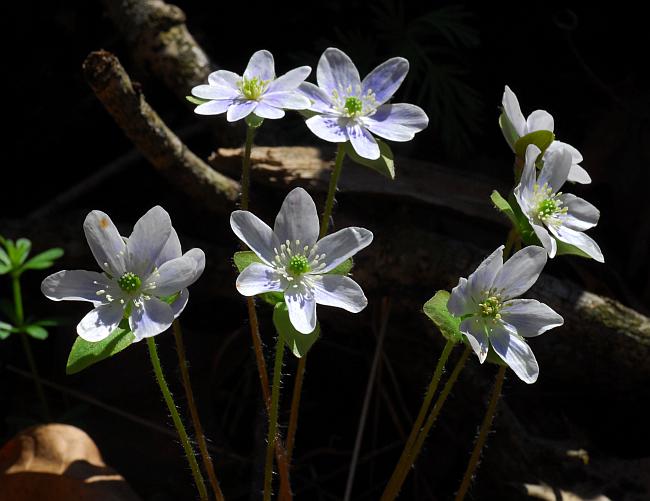Hepatica acutiloba DC.
Sharp-Lobed Hepatica

Native
CC = 7
CW = 5
MOC = 41
© SRTurner
Hepatica acutiloba DC.Sharp-Lobed Hepatica | |
 |
Native CC = 7 CW = 5 MOC = 41 |
© SRTurner |
|
Family - Ranunculaceae Habit - Rhizomatous perennial forb. Stems - Scapose, 8-17 cm long, unbranched, usually densely hairy.
Leaves - Basal leaves 2-12, usually darkened to maroon or dark purple at flowering, sometimes absent, long-petiolate, densely long-pilose beneath when young but becoming glabrate with age, 3-lobed for 60-80% of their length, the lobes 27-40 mm wide, entire, bluntly to sharply pointed at the tip.
Inflorescence - Flowers solitary on stems, each subtended by 3 involucral bracts, these sessile, lanceolate to ovate, bluntly pointed to rounded at the tip, densely hairy, the margins entire.
Flowers - Actinomorphic, perfect. Sepals petaloid, 5 to 8, 7-16 mm long, white, pink, or pale blue, deciduous. Petals absent. Head of fruits 5-6 mm long, 9-11 mm in diameter, hemispherical.
Fruits - Achenes, elliptic in outline, sparsely to moderately pubescent with straight hairs not concealing the surface, the beak 0.5-1.0 mm long, brittle and often broken off. Receptacle not enlarged at fruiting.
Flowering - February - April. Habitat - Forests, north-facing slopes, rock outcrops, shaded ledges, usually on calcareous substrate. Origin - Native to the U.S. Lookalikes - H. americana. Other info. - This beautiful springtime ephemeral wildflower is found mostly in the eastern half of Missouri. Its range in the continental U.S. comprises a triangular area stretching from mid-Minnesota on the northwest, to southern Alabama on the south, to Maine on the northeast. In Missouri it is not particularly common, being found only in relatively undisturbed, rich, shaded forests and bluffs. Photographs taken at St. Francois State Park, St. Francois County, MO, 3-23-2105 and 3-28-2016, Little Lost Creek Conservation Area, Warren County, MO, 4-1-2015, 3-26-2016, and 4-1-2017, and Washington State Park, Washington County, MO, 4-15-2019 (SRTurner). |